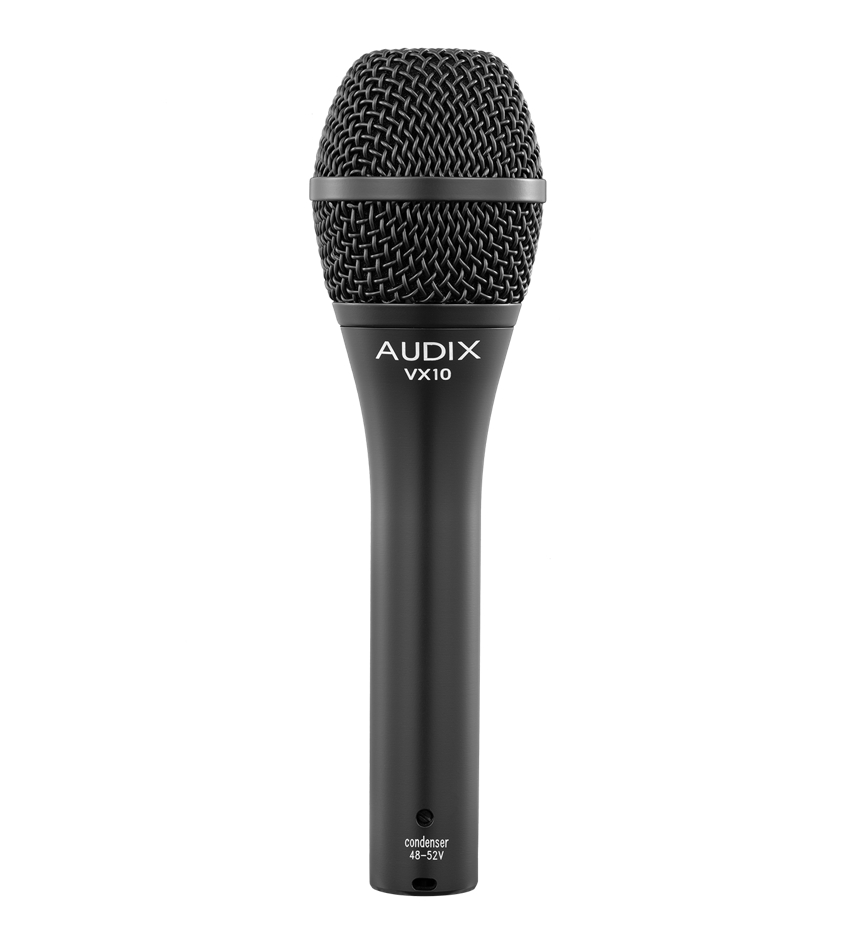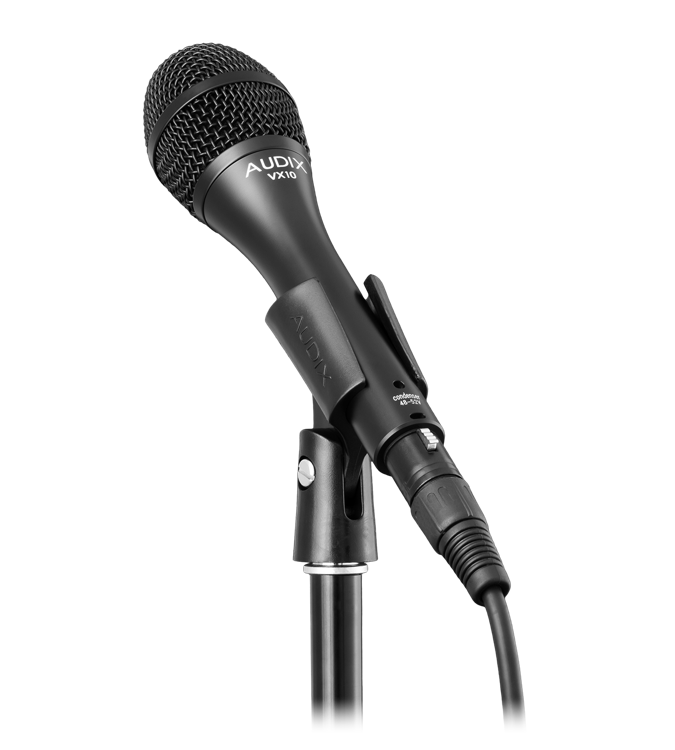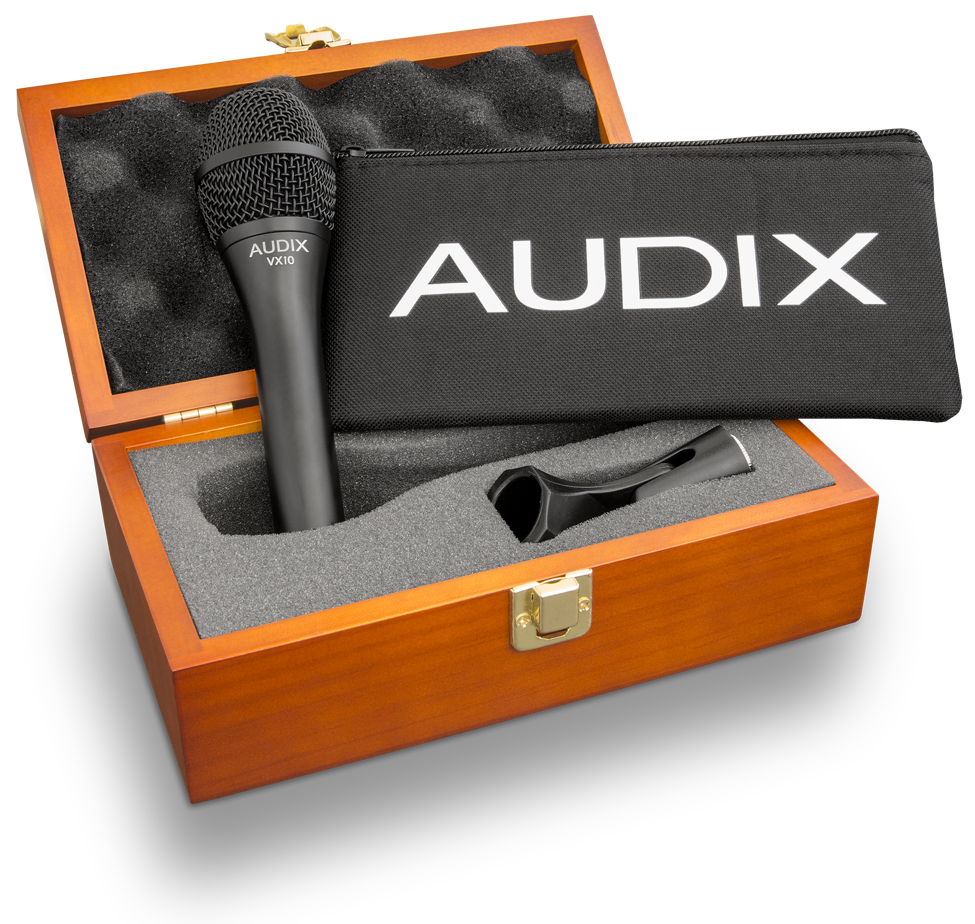Vragen? Betere prijs gezien?
Bel 0512 - 340457 of neem contact op!
Product omschrijving
VX10
Elite condenser vocal microphone
The VX10 condenser vocal microphone was designed to set new performance standards for live sound and broadcast applications. With a uniformly controlled frequency response from 40 Hz – 20 kHz, the VX10 is highly sensitive to transient response and will reproduce vocals and speech with exceptional detail and realism.
The VX10 has a cardioid polar pattern which helps isolate vocals. This mic includes a 21 mm gold vapor capsule and a multi-stage internal pop filter. It is also available in a low output model (VX10LO) for greater control with loud stage volumes or extremely powerful vocalists.
Aside from vocals, the VX10 cardioid condenser microphone will capture acoustic instruments such as guitars, woodwinds, brasses, percussion toys, drum overheads, hi-hats, and pianos.
Designed, machined, assembled, and tested by Audix in Wilsonville, Oregon.

FEATURES
- Elite condenser vocal mic with studio quality sound
- Reproduces vocals and speech with exceptional detail
- 21 mm gold sputtered diaphragm
- Ideal for broadcast and live recording
APPLICATIONS
- Studio vocals
- Lead or backing vocals
- Speech
- On air announce microphone
- Live performance and broadcasts
- Excellent for use with in-ear monitors
- Acoustic instruments
SUPPLIED ACCESSORIES
- POUCHAXSM - Protective zippered carrying case
- MC1 – Heavy duty nylon molded snap on clip
- P1 – Carrying pouch
OPTIONAL ACCESSORIES
- TRIPOD – Metal tripod desktop mic stand
- STANDKD – Short pedestal stand with telescoping boom arm
- DFLEX – Dual pivot rim mounted clip with extra wide butterfly jaws
- CBL20 – 20’ premium XLR-XLR balanced mic cable. Quad conductor, twisted pair with braided shield for conductivity. 6 mm PVC jacketed
- CBLDR25 – 25’ premium right angle XLR balanced mic cable. Quad conductor, twisted pair with braided shield for conductivity. 6 mm PVC jacketed
- WS10 - External foam windscreen
- APS2 - Two-channel 48 V phantom power supply for condenser microphones. 110 V switchable to 240 V. Detachable power cord.
SPECIFICATIONS
Transducer: Condenser
Frequency Response: 40 Hz - 16.5 kHz
Polar Pattern: Cardioid
Output Impedance: 250 ohms
Sensitivity: 24 mV / Pa @ 1 kHz - VX10LO - 4mV / Pa @ 1 kHz
Equivalent Noise Level: 19 dB (a-weighted)
Signal to Noise Ratio: 75 dB
Maximum SPL: >138 dB (w/ -10 pad)
Off-Axis Rejection: >20 dB
Polarity: Positive pressure on diaphragm produces positive voltage on pin 2 relative to pin 3 of output XLR connector
Power Requirements: 48-52 V
Connector: 3-pin XLRm
Materials / Finish: Zinc Alloy & Machined Brass / Black
MODEL VARIATIONS
VX10LO - For high SPL applications and close proximity vocals

OPERATION AND MAINTENANCE
The VX10 is a low impedance microphone and should be plugged into a ‘mic level’ input on your console, mixer or recording device. The VX10 requires phantom power and will NOT operate without phantom power voltage (48 Volts recommended) which is available on most professional mic preamps and mixing devices. Phantom power will be needed on your equipment (such as the Audix APS2).
Avoid plugging or unplugging the microphone from a PA system unless the channel is muted or the volume of the system is turned down. Failure to do so may result in a loud ’popping’ noise which could seriously damage the speakers in the PA system.
The VX10 & VX10L are manufactured to exacting specs with roadworthy construction. However, the capsule is highly sensitive and should be handled with care. Avoid extreme temperatures and be sure to store your microphone in the pouch provided when not in use. Moisture of any kind can adversely effect the sound and performance of your microphone.
USER TIPS
TheVX10, an excellent choice for lead and background vocals, has a cardioid pick-up pattern which helps to minimize sound from other instruments on stage from ‘bleeding’ into the microphone. The VX10 is highly sensitive and will accommodate working distances of 1-12 inches from the performers mouth. Depending on the instrumentation and volume on stage, the vocalist may have to experiment to find the optimum working range.
When using stage monitors, avoid pointing the back of the microphone directly into the stage monitor. Instead, set the microphone at an angle parallel to the floor, putting the angle of the mic on a different plane with the angle of the monitor. Allow a distance of 2-3 feet between microphones to avoid phase cancellation issues.
Further miking techniques may be found at www.audixusa.com.

 Product is toegevoegd aan uw winkelwagen
Product is toegevoegd aan uw winkelwagen





